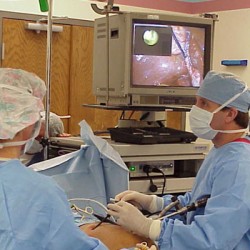What is Common Bile Duct Stone (Choledocholithiasis, Cholangitis, Obstructive Jaundice)?
Choledocholithiasis is a disease of the common bile duct. The common bile duct forms at the junction of the cystic duct (from the gallbladder) and the common hepatic duct (from the liver). It drains bile into the duedenum (the first part of the small intestine).
Gallstones (cholesterol stones or pigment stones) form in the gallbladder over many years. They can sometimes travel into the common bile duct, causing a blockage. If the common bile duct is blocked, this then obstructs the whole of the biliary drainage system as opposed to a blockage further up. Hence there is nowhere for the bile to go but up and the patient becomes jaundiced since certain waste products (bilirubin) are absorbed back into the bloodstream. Furthermore, there can be potentially fatal complications of infection of the biliary tree (cholangitis) and acute pancreatitis.
Statistics on Common Bile Duct Stone (Choledocholithiasis, Cholangitis, Obstructive Jaundice)
Passage of gallstones into the common bile duct occurs in approximately 10-15% of patients with Gallstones. The incidence is thus related to the presence of gallstones, which are very common (10-20% of population).
Risk Factors for Common Bile Duct Stone (Choledocholithiasis, Cholangitis, Obstructive Jaundice)
The predisposing factors for common bile duct stones are the same as for Gallstones. Risk factors for cholesterol stones include: high serum cholesterol leves, increased age, female sex, obesity, rapid weight loss, the contraceptive pill, and total parenteral nutrition.
Risk factors for pigment stones include chronic hemolysis (red blood cell breakdown) -hereditary spherocytosis, sickle cell disease, as well as liver cirrhosis. They may also form in the bile ducts after cholecystectomy (surgical removal of the gallbladder).
Progression of Common Bile Duct Stone (Choledocholithiasis, Cholangitis, Obstructive Jaundice)
A blockage in the common bile duct will lead to obstructive jaundice since there can be no outflow of bile. The complications that ensue are important:
- Acute Cholangitis: There is infection of the stagnant bile which can ascend to the liver.
- Hepatic abscess: As a result of ascending infection in cholangitis;
- Pancreatitis: The blockage of the bile duct also affects the pancreas;
- Secondary Biliary Cirrhosis: With time, in cases of prolonged obstruction there is inflammation, then fibrosis and scarring of the liver, which leads to cirrhosis.
How is Common Bile Duct Stone (Choledocholithiasis, Cholangitis, Obstructive Jaundice) Diagnosed?
- Full blood count – elevated white cell count signifying infection.
- Liver function tests – elevated bilirubin, evidence of stasis.
- Blood cultures – frequently positive in cholangitis.
- Amylase/Lipase – may be elevated if there is an element of pancreatitis.
Prognosis of Common Bile Duct Stone (Choledocholithiasis, Cholangitis, Obstructive Jaundice)
Choledocholithiasis on its own is not necessarily associated with increased mortality or marked morbidity. It’s complications, however, can be. Cholangitis is common and may respond relatively rapidly to supportive measures and antibiotics but it can also be fatal if urgent relief of the obstruction and drainage of infected bile is not carried out. Pancreatitis can also be a severe complication.
Secondary Biliary Cirrhosis has a similar prognosis as cirrhosis from other causes, since once cirrhosisdevelops, it is largely irreversible. The widespread use of ERCP has, however, decreased the incidence of complcatedbilary tract disease.
How is Common Bile Duct Stone (Choledocholithiasis, Cholangitis, Obstructive Jaundice) Treated?
If the patient has Cholangitis
- Analgesia (narcotics) and IV antibiotics (amoxycillin, metronidazole and gentamicin) are given.
If the obstruction needs to be relieved, this can be done using: - ERCP (Endoscopic Retrograde Cholangiopancreatography) is performed to cut the sphincter connecting the common bile duct to the duedenum, to allow the stone to pass into the intestine relieving the obstuction. If there is any suspicious pathology this may be biopsied.
- A cholecystectomy may be indicated at the same time or a later date.
